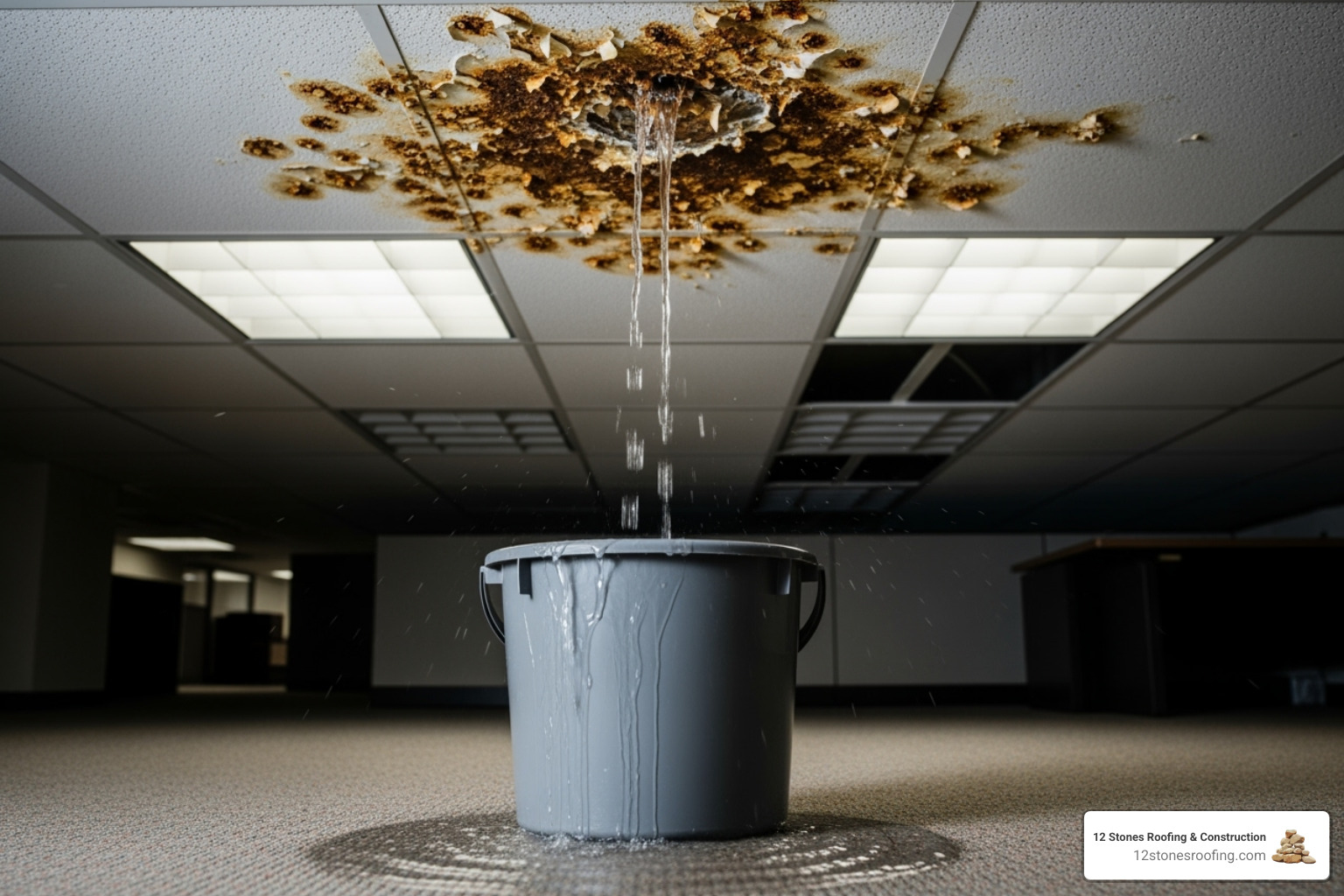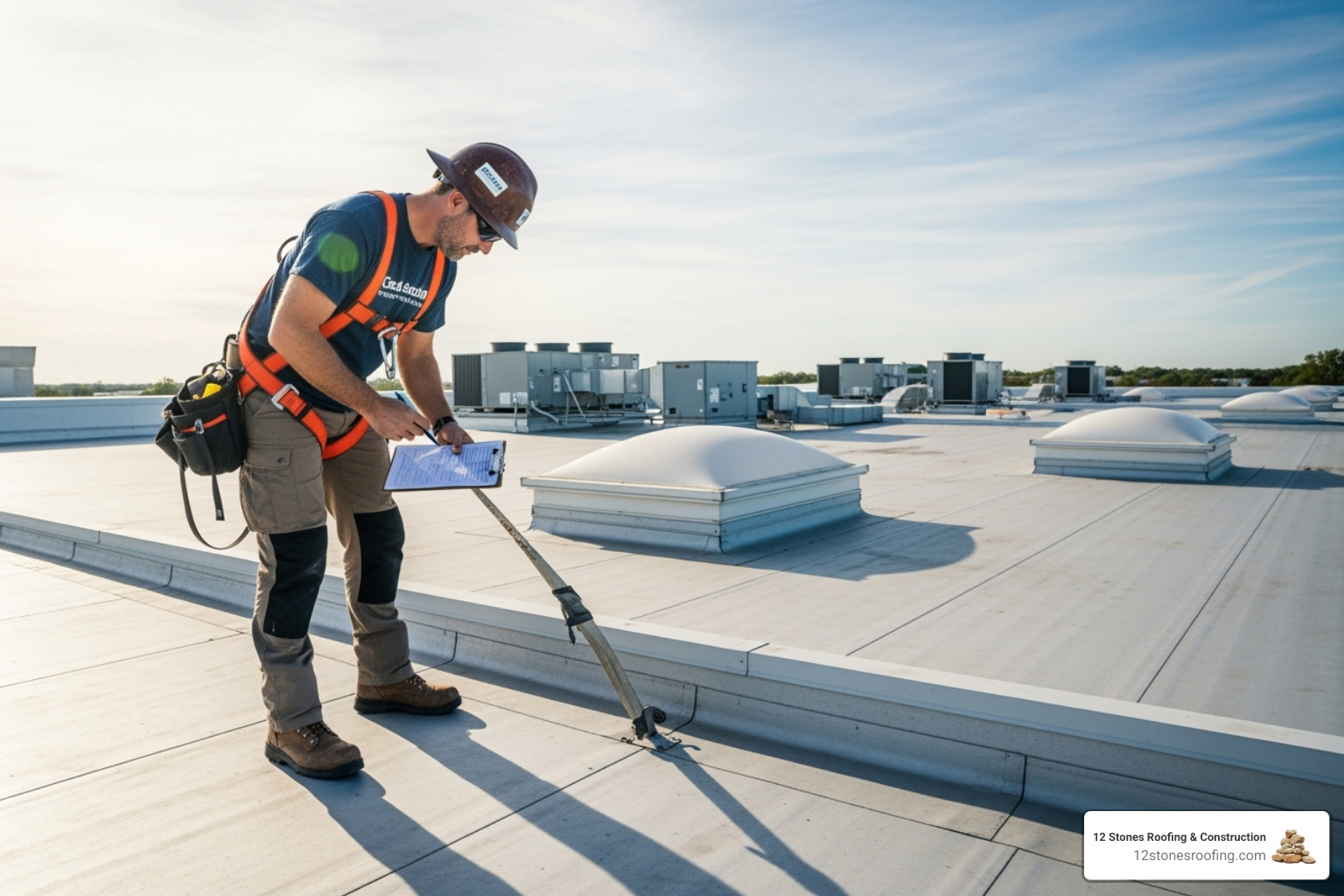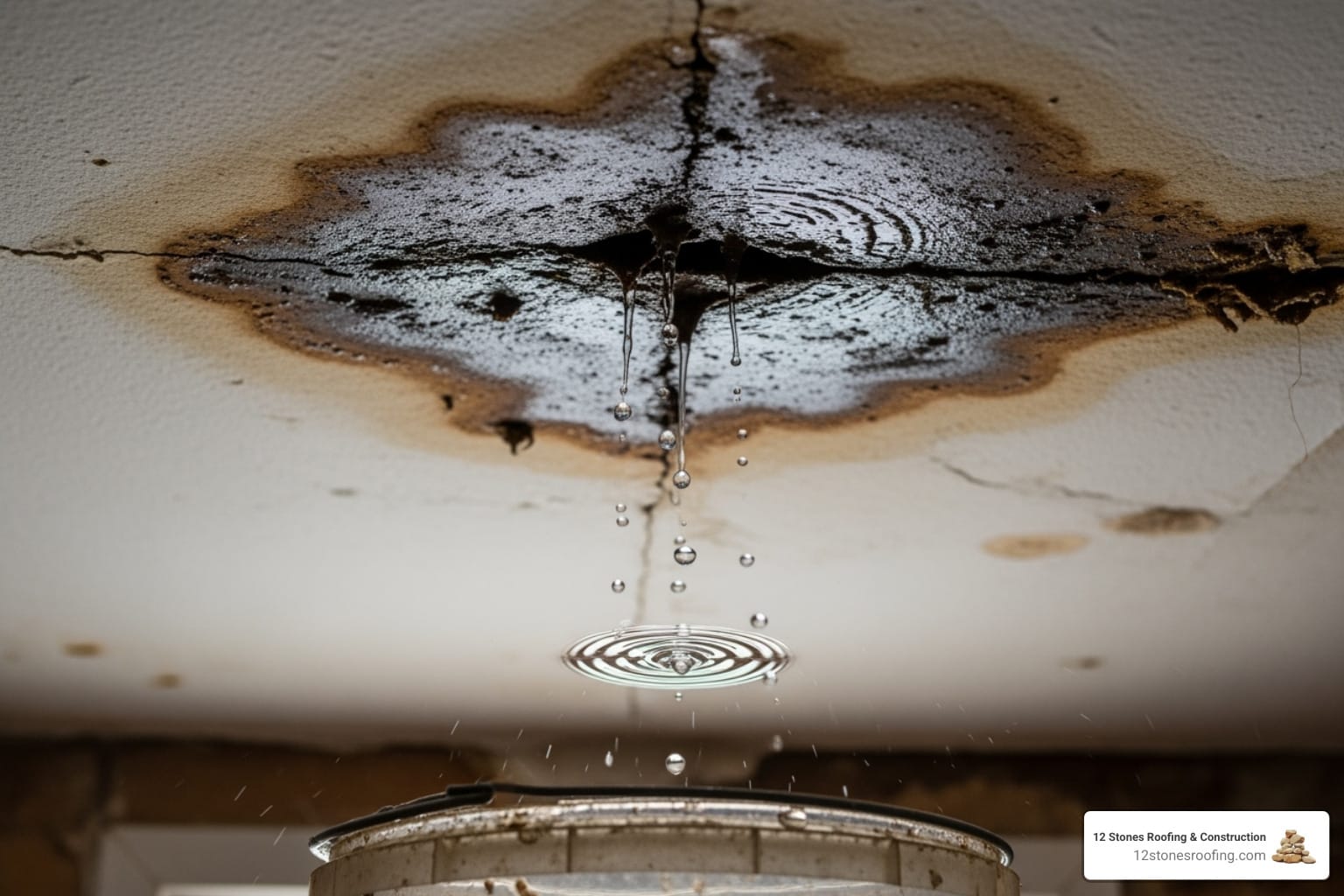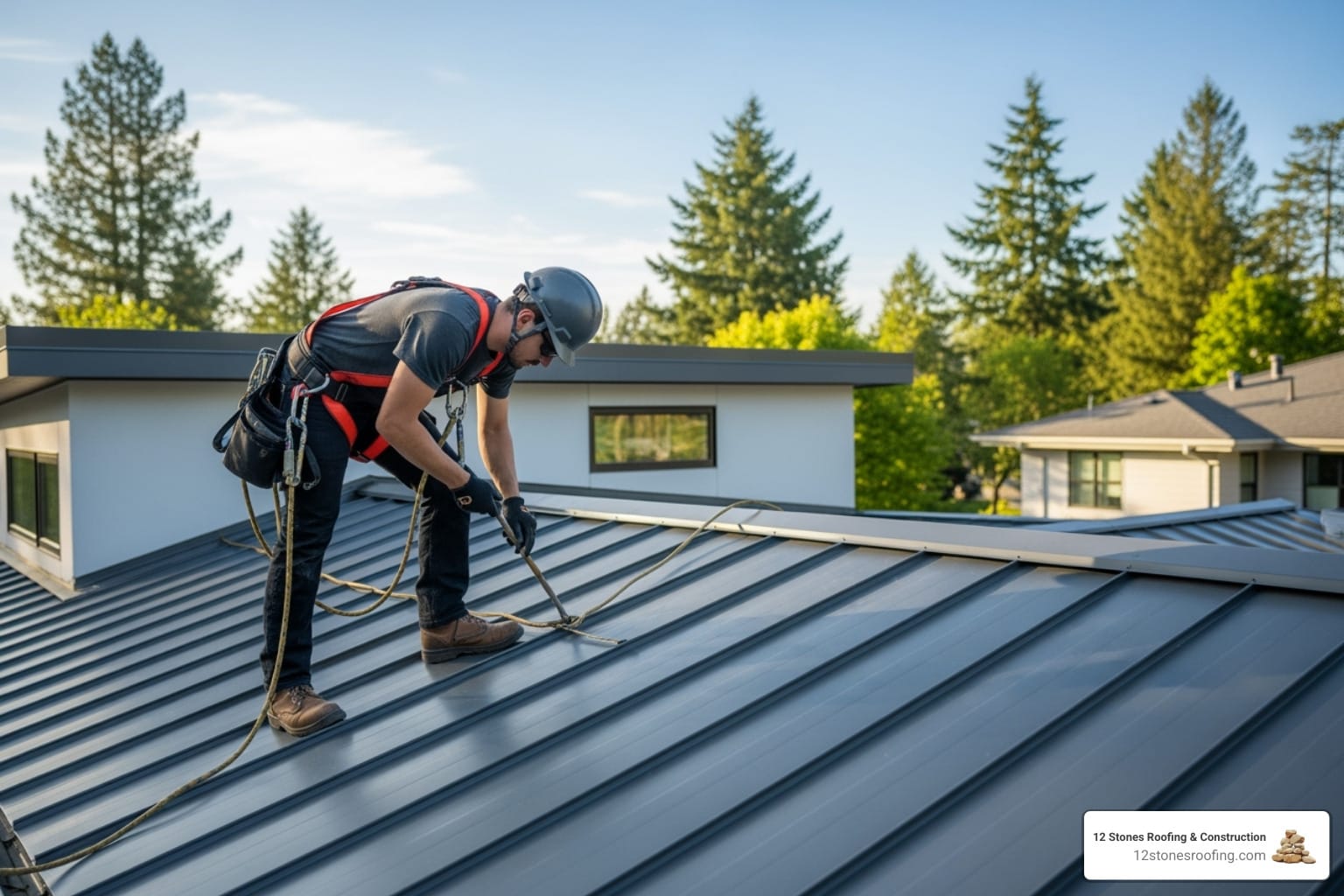Why Commercial Emergency Roofing Demands Your Immediate Attention
Commercial emergency roofing is a critical service that addresses sudden, severe roof damage threatening your building’s safety, operations, and assets. When disaster strikes—whether from a violent Gulf Coast storm, fallen debris, or structural failure—the clock starts ticking. As a leading Pasadena roofing company, we know that potential losses can mount into thousands of dollars per hour from inventory loss, equipment damage, and operational downtime.
What You Need to Know About Commercial Emergency Roofing:
- Response Time Matters: Professional emergency roofing teams can typically dispatch within 2-4 hours and complete temporary stabilization the same day.
- Common Triggers: Severe weather (wind, hail, rain), fallen trees, fire damage, or collapsed roof sections.
- Immediate Actions: Prioritize safety, document all damage, protect interior assets, and contact a 24/7 emergency roofing contractor.
- Cost Reality: Emergency repairs typically cost 25-40% more than scheduled work but prevent exponentially higher costs from water damage and business interruption.
- Insurance Coverage: Most commercial policies cover sudden, unexpected damage—thorough documentation is essential for claims.
The difference between a manageable crisis and a business catastrophe often comes down to how quickly you respond. A small leak can quickly become a major structural problem when water infiltrates insulation, electrical systems, and load-bearing components. Prompt action in the first 48 hours is crucial to minimize damage and protect your bottom line.

What Is a Commercial Roofing Emergency?
When your roof suddenly fails, you’re not dealing with an inconvenience—you’re facing a commercial roofing emergency. This is any unexpected roof failure that puts people at risk, threatens your building’s structure, or endangers the equipment and operations that keep your business running. The key difference between an emergency and a routine repair is time. While minor issues can wait, an emergency demands immediate action to prevent water from seeping deeper, spreading damage, and escalating repair costs.
Common Causes of Commercial Roof Emergencies
In Pasadena and the Gulf Coast region, severe weather is the leading cause of emergency calls. Understanding the triggers can help you prepare.
- Severe Weather: Hurricanes, tropical storms, and thunderstorms can tear off roofing membranes, rip away flashing, and create punctures, exposing your building’s interior to the elements.
- Hail Damage: Hailstones can bruise or puncture TPO, EPDM, and modified bitumen roofing systems, compromising the watertight seal. Large hail can cause immediate, visible damage that demands urgent attention.
- High Winds: Sustained gusts can lift and peel back entire sections of roofing membrane, dislodge metal coping, or tear away protective layers, leaving your building’s interior completely exposed.
- Fallen Trees or Debris: A large branch or tree trunk crashing onto your roof can create massive punctures or even cause a partial roof collapse.
- Fire Damage: Beyond visible destruction, fire can compromise the entire roof structure, making a professional assessment absolutely critical.
- Sudden Structural Failure: This can happen when a roof can no longer support its load due to structural defects, overloading, or water saturation.
- Poor Installation: Improperly sealed seams or incorrectly installed flashing can fail suddenly during a storm, even years after the initial installation.
- Neglected Maintenance: Years of deferred repairs weaken your roof until a relatively minor storm triggers major damage. Proactive maintenance is the best way to prevent this. Learn more about roof damage from rain and how small issues can escalate.
Critical Warning Signs That Demand Immediate Action

Your roof often sends signals before a complete failure. These signs mean you need to act immediately, not tomorrow or next week.
- Active and Significant Roof Leaks: If you see steady streams of water or widespread intrusion threatening equipment, inventory, or electrical systems, it’s an emergency.
- Visible Punctures or Holes: Any breach in your roof’s protective layer compromises the entire system and allows water to infiltrate.
- Sagging Roof Deck or Ceiling: This is one of the most serious warnings, indicating severe water saturation or structural failure. Evacuate the area immediately and call for professional help.
- Interior Water Stains Appearing or Growing Rapidly: Stains that spread quickly mean water is actively pouring into your building.
- Missing Sections of Roofing Material: If you can see exposed areas from the ground or inside, your roof has lost its ability to protect your building.
- Sounds of Dripping Water Inside Walls: This indicates water has penetrated deep into your building’s structure, where it can cause extensive hidden damage and mold growth.
- Flashing That Is Clearly Detached or Damaged: Damaged flashing around parapet walls, skylights, or HVAC units creates easy entry points for water.
Your First 48 Hours: An Emergency Action Plan for Business Owners
When a commercial roof emergency strikes, a calm, methodical response can significantly reduce the overall damage and cost. The right actions in the first few hours make all the difference.
Step 1: Prioritize Safety Above All Else
Before anything else, you must ensure the safety of your employees, customers, and anyone on the property.
- Evacuate Immediately: If there are any signs of structural instability, such as sagging ceilings or active collapse, evacuate the affected areas. Cordon off hazardous zones with cones or tape.
- Manage Electrical Hazards: Water and electricity are a dangerous mix. If leaks are near electrical panels, outlets, or equipment, shut off power to those areas to prevent fires or electrocution. If unsure, call an electrician.
- Stay Off the Roof: Never send untrained personnel onto the roof to assess damage. A compromised roof is unstable, slippery, and extremely dangerous. Leave inspections to trained professionals.
Step 2: Mitigate Interior Damage
Once safety is secured, your next priority is to minimize damage to your building’s interior and its contents. Every minute counts when water is entering your property.
- Relocate Valuables: Move equipment, inventory, and important documents away from the leak to a dry area. If items are too heavy to move, cover them with waterproof tarps.
- Contain the Water: Place buckets and other containers to catch dripping water. Use heavy-duty plastic sheeting to protect larger areas. Lay down absorbent materials on the floor to soak up water and prevent it from spreading.
Step 3: Document Everything for Insurance
Thorough documentation is your best tool for a smooth insurance claim process. The more evidence you have, the better.

- Take Photos and Videos: From a safe location on the ground, take clear photos and videos of the exterior roof damage. Ask your roofing professional to take detailed photos from the roof itself.
- Document Interior Damage: Photograph all water stains, damaged ceiling tiles, soaked carpets, and affected equipment. Date and timestamp your media.
- Keep a Detailed Log: Note when the damage occurred, when you noticed it, and when you contacted your insurance company and roofing contractor. This timeline is invaluable for your claim. More info about roof inspection for insurance can help you prepare for the adjuster’s visit.
Step 4: Call a 24/7 Emergency Roofing Professional
Once you’ve handled immediate safety and mitigation, bring in the experts. A faster professional response means a faster resolution.
- Contact a Qualified Contractor Immediately: Look for a contractor that offers 24/7 emergency services and has a reputation for prompt action. When you call, provide a clear description of the emergency.
- Confirm Rapid Response: Ask for an estimated arrival time. For critical emergencies, a professional team should be able to respond within hours, not days.
- Verify Experience: Ensure the contractor has proven expertise with your specific roof type, whether it’s TPO, EPDM, metal, or another system. Different materials require specialized knowledge for effective emergency repairs.
Choosing the Right Partner for Commercial Emergency Roofing
The contractor you choose will determine the speed and quality of your recovery. Not all roofers are equipped for a commercial emergency roofing situation, and making the right choice in the first few hours can save you thousands of dollars and weeks of downtime.
Key Qualities of an Emergency Roofing Contractor
When your business is at risk, you need a partner with the resources and expertise to respond immediately and effectively.
- True 24/7/365 Availability: Emergencies don’t follow a 9-to-5 schedule. Your contractor should have a dedicated emergency line, like our (713) 715-ROOF, staffed by a real person who can dispatch a crew.
- Local Presence: A local contractor based in the Pasadena, TX, area can arrive on-site within hours, not days. This is critical for minimizing damage from Gulf Coast weather.
- Proper Licensing and Insurance: Verify that any contractor has full liability insurance and worker’s compensation. This protects your business from liability during the repair process.
- Experience with Your Roof Type: Commercial roofing is not one-size-fits-all. A contractor must have proven experience with various commercial roofing systems, from TPO and PVC to metal and modified bitumen.
- Strong Reputation: Look for positive reviews and testimonials that mention responsiveness, quality of work under pressure, and clear communication during an emergency.
How Emergency Services Differ from Routine Maintenance
Emergency services and routine maintenance serve two different but equally vital purposes for your roof’s health.
| Aspect | Emergency Service | Routine Maintenance |
|---|---|---|
| Response Time | Immediate/within hours | Scheduled |
| Goal | Stabilize and make watertight | Preventative care and minor repairs |
| Cost | Premium rates for rapid response | Standard rates |
| Scope | Triage and temporary solutions followed by permanent repair | Inspection, cleaning, and scheduled repairs |
Emergency service is reactive. The immediate goal is to stop the damage by making the roof watertight, protecting the interior, and stabilizing any structural threats. This may involve deploying heavy-duty tarps or performing rapid patching. The premium rates, typically 25-40% higher, reflect the cost of immediate mobilization but prevent far greater losses from business interruption and water damage.
Routine maintenance is proactive. It involves scheduled inspections to find and fix minor issues before they become emergencies. It is the most cost-effective way to extend your roof’s lifespan and prevent crises. For swift, expert assistance when disaster strikes, our dedicated emergency roofing services team is ready to protect your business.
From Crisis to Control: Navigating Repairs, Insurance, and Future Prevention
Once temporary repairs have secured your building, the focus shifts from crisis mode to recovery. This phase involves permanent repairs, navigating the insurance process, and implementing a strategy to prevent future emergencies.
Navigating Your Commercial Property Insurance Claim
Most commercial property insurance policies cover commercial emergency roofing repairs from sudden, unexpected events like storms or fire. However, damage from neglect or deferred maintenance is typically not covered.
- Understand Your Policy: Review your policy for coverage related to “sudden and accidental” damage. Your insurance agent can clarify the specifics.
- Provide Detailed Documentation: The photos, videos, and logs you created are the foundation of your claim. This evidence proves the extent of the damage to the adjuster.
- Work with Your Contractor: A professional roofing contractor can provide detailed damage assessments and repair estimates that insurance companies trust. We frequently work with adjusters to ensure they have the information needed to process claims quickly.
The High Cost of Delay: Risks of Postponing Repairs
While emergency repairs come at a premium, delaying them almost always costs more. The risks of waiting are significant:
- Compromised Structural Integrity: Water saturation weakens roof decking and support beams, potentially leading to partial collapse and far more expensive reconstruction.
- Widespread Mold and Mildew: Mold can begin colonizing within 24-48 hours of water intrusion, leading to health risks and costly remediation.
- Damaged Insulation and Energy Loss: Wet insulation loses its R-value, forcing your HVAC system to work harder and driving up utility bills, a significant cost in the Texas heat.
- Business Interruption: A compromised roof can force you to shut down operations, leading to lost revenue that can quickly exceed the cost of the repair.
- Increased Final Repair Costs: A minor leak that could have been a small repair can grow into a major reconstruction project if left unaddressed, increasing costs exponentially.
Proactive Protection: How to Prevent Future Emergencies

Most commercial roofing emergencies are preventable. A proactive approach is the best defense against future crises.
- Implement a Professional Roof Maintenance Plan: According to the National Roofing Contractors Association, professionally maintained roofs last up to 50% longer. A plan includes routine inspections, cleaning, and minor repairs.
- Schedule Semi-Annual Inspections: Spring and fall inspections allow professionals to catch minor cracks, loose flashing, and worn sealants before they fail. Post-storm checks are also recommended.
- Keep Gutters and Drains Clear: Clogged drainage is a leading cause of roof failure. Ponding water accelerates deterioration and adds stress to the structure.
- Address Minor Issues Promptly: Small investments in proactive repairs, like patching a tear or resealing a joint, prevent catastrophic failures and save enormous amounts in emergency costs.
For immediate assistance with a commercial roof emergency in the Pasadena, TX area, contact our 24/7 response team.
Frequently Asked Questions about Commercial Roof Emergencies
When your business faces a roofing crisis, questions come fast. Here are answers to the most common concerns we hear from business owners in Pasadena, TX.
Do emergency commercial roof repairs cost more than scheduled repairs?
Yes, emergency commercial roof repairs typically cost 25-40% more than scheduled work. This premium is not arbitrary; it covers the significant costs of immediate mobilization. This includes deploying a crew outside of normal business hours (often at night or on holidays), expediting materials from suppliers at a higher rate, and using specialized equipment for safe work in hazardous conditions. While the upfront cost is higher, this investment prevents far greater expenses from unchecked water damage, structural failure, and business interruption, which can multiply the final cost by three to five times.
Can temporary repairs be performed during an active storm?
Safety is always the top priority. Comprehensive, permanent repairs cannot be performed during high winds, heavy rain, or lightning. However, an emergency crew can often perform critical temporary stabilization measures during a break in the weather. This may include securing large, reinforced tarps over the damaged area or installing water diversion systems to redirect water away from sensitive interior assets. These temporary fixes are crucial to protect your facility until conditions are safe enough for a full, permanent repair.
How long does an emergency commercial roof repair take?
The timeline depends on the severity of the damage. A professional emergency team can typically be on-site within two to four hours of your call. A temporary fix to make the building watertight, such as patching a puncture or tarping a section, can often be completed the same day. More complex, permanent repairs involving structural damage or large-scale replacement may take one to several days. The timeline is also affected by material availability and weather conditions. We provide a clear, honest timeline during our initial assessment and keep you updated throughout the process.
Secure Your Business with a Trusted Roofing Partner
A commercial roofing emergency is a serious threat, but it does not have to become a catastrophe. With an understanding of the warning signs, a plan for rapid response, and a qualified emergency contractor on call, you can protect your property, minimize costly downtime, and safeguard your business.
Preparedness and prompt action are your greatest allies. The businesses that recover fastest are the ones that act decisively and partner with professionals.
At 12 Stones Roofing & Construction, our expert team is equipped to handle your urgent roofing needs with speed and professionalism. We are available 24/7/365 because emergencies don’t wait for business hours. When your roof fails, our local team is ready to protect your property and guide you through recovery.
For immediate assistance with a commercial emergency roofing crisis in the Pasadena, TX area, contact our 24/7 response team online. You can also visit our local page for roofers near me Pasadena to learn more about our services in your area.





